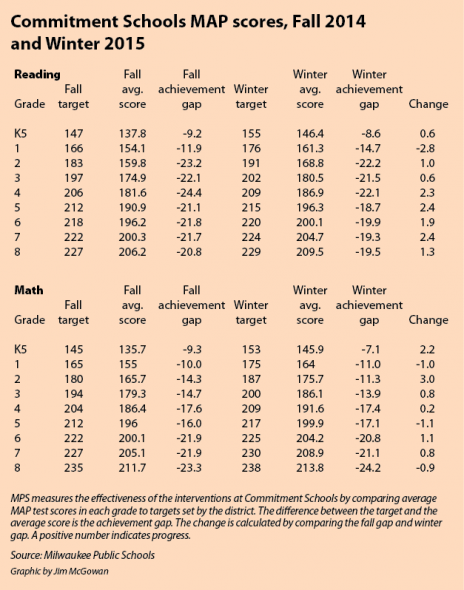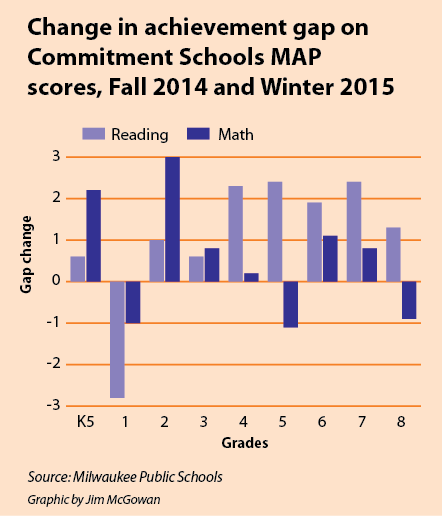MPS Commitment Schools Show Improvement
Federally funded schools have raised student achievement in reading and math.

Students at Thurston Woods, which is one of 14 underperforming MPS schools participating in the Commitment Schools program, work on assignments. (Photo by Molly Rippinger)
Standardized test scores have Milwaukee Public Schools administrators expressing optimism about the outcome of academic and behavioral interventions implemented last fall at 14 underperforming schools through the Commitment Schools program.
Results from Measures of Academic Success (MAP) testing administered in the fall and winter indicate that the majority of K-8 Commitment Schools are closing the achievement gap in both mathematics and reading.
“Overall, we are moving in the right direction,” said Dr. Darienne Driver, superintendent of MPS.
Achievement gaps are based on MAP testing and measure the disparity between students’ scores and the scores needed to be considered proficient.
Testing data showed that in K-8 Commitment Schools eight of the nine grades narrowed the achievement gap in reading while six of the nine grades made similar gains in math.
In reading, the greatest reduction in the achievement gap occurred in fifth and seventh grades; the gap increased in first grade. In math, the gap narrowed the most in second grade, and increased in first, fifth and eighth grades.
“This means that the [Commitment School] students are growing faster than average,” said Dr. Melanie Stewart, director of assessment at MPS. Administrators are confident that the gains will continue in the final round of MAP testing, which is administered in May.
MPS expected that Commitment Schools would reduce the achievement gap by 5 percent following the first year of academic and behavioral interventions.
“This is our first look at the progress we are making in our Commitment Schools,” said Driver in a news release. “We are pleased to see that outcomes for students are improving.”
The program provided $300,000 in federal funds to each school to be allocated in $100,000 increments over a three-year period. Commitment Schools have used the funds to increase professional development, implement improvement systems, upgrade technology and hire additional staff.
Ruth Maegli, chief innovation officer at MPS, explained that each Commitment School adopted interventions that address its specific needs. “Everybody chose something different because their population and their staff needed support in different areas,” said Maegli.
Thurston Woods
Thurston Woods Campus, 5966 N. 35th St., used the funding to hire Katrina Edmond, a “building intervention” teacher focused on working with K-8 students to improve math and reading skills. Mark Peterson was also hired as a “school support” teacher who aids Edmond.
“I’m really excited about the progress our students have made and the hard work our teachers have put forward to make sure that our students are learning,” said Keona Jones, principal of Thurston Woods.
At Thurston Woods, six of the nine grade levels are closing the achievement gap in both math and reading scores.
“This is working for us,” said Jones. “We think that the building intervention program was key for having these kind of outcomes.” Jones and her staff have found the supplemental lessons to be an effective catalyst for improvement.
In the previous academic year, only three of the nine grades at Thurston Woods reduced the achievement gap between fall and spring in reading while five of the nine grades narrowed the gap in math during the same time period.
All Thurston Woods students work with Edmond and Peterson four times each week in 15-minute increments, twice in reading and twice in math. “Students can be resistant to being pulled out of class, but we’re working with both the high-achieving students and students who need improvement — it’s an equalizer,” explained Jones.
The one-on-one approach has helped teachers at Thurston Woods create individualized MAP testing goals for their students. The data are also used to implement Response to Intervention (RtI), a framework used throughout MPS to monitor student progress through a tiered system of evaluation and action.
Another portion of the behavioral intervention strategy for Thurston Woods was to implement RtI at the beginning of September using the student testing data from the previous spring. Other MPS schools waited until the first round of MAP testing at the end of October.
Thurston Woods accelerated RtI by identifying 85 students at the beginning of September whose spring test scores indicated that they needed interventions to become proficient. After the first MAP assessment, 40 students showed enough improvement to no longer require additional support. Another 140 students began RtI in November and 45 students were dismissed after the second round of MAP testing.
“It was so nice that when we should’ve been just starting RtI we were already exiting students that didn’t need further interventions,” said Jones.
Thurston Woods was one of 48 MPS schools that “failed to meet expectations” set by the Wisconsin Department of Public Instruction (DPI) last year. All of the underperforming schools were encouraged to apply for the Commitment Schools program by submitting a formal proposal that detailed what resources would be added and systems implemented to improve academic achievement. MPS has not calculated achievement gaps for the other 34 underperforming schools.
Other elementary or middle schools participating in the program are Auer Avenue School, Browning School, George Washington Carver Academy of Mathematics and Science, Samuel Clemens School, Barack Obama School of Career and Technical Education and Albert Story School.
MPS is hoping interventions made at the secondary education Commitment Schools will result in a 10 percent increase in high school students meeting requirements for the ACT, a standards- and curriculum-based test used to assess students’ readiness for college. Data will not be available until after testing is administered in the spring.
“We’re really just at the beginning,” stressed Maegli. “You have to remember this is a three-year program.”
As of now, Maegli explained that there are no concrete plans to expand the Commitment Schools program to include any other MPS schools that failed to meet expectations in 2013-2014. Yet, Maegli said that the thought of replication is always on the minds of MPS administrators.
Jones said she is already planning for the end of the Commitment Schools grant and is looking for ways to continue funding the building intervention teacher within the existing school budget.
“It has made such a difference to have a person working in a small, group setting with the students,” said Jones. “I’m already thinking about how we’ll maintain a similar system at the end of the three years.”
This story was originally published by Milwaukee Neighborhood News Service, where you can find other stories reporting on fifteen city neighborhoods in Milwaukee.
If you think stories like this are important, become a member of Urban Milwaukee and help support real, independent journalism. Plus you get some cool added benefits.






















Doesn’t it trouble anyone that this is seen as a GAP problem? What motivation is there to help those at the top of the class if their improvement will only increase the gap? I realize that it is difficult for students who struggle, but it is at least as painful for those other students who are bored.
@Read Speeder – Thanks for your sharing your concern. I wanted to share a couple of points:
– Improvements among higher-performing students in MPS’ Commitment Schools would not widen the gap we are measuring here. We are measuring the gap between the scores of the average student in the Commitment Schools and the score needed to predict proficiency in the content area.
– At Thurston Woods Campus, the school profiled in the piece, one of the key supports provided through the Commitment Schools effort — the Building Intervention Teacher — works both with students who are behind to bring them up to speed and with students who are ahead to keep them challenged.
I hope that information is helpful for you to have. Let me know if it’s not clear.
Thanks,
Tony Tagliavia
Milwaukee Public Schools